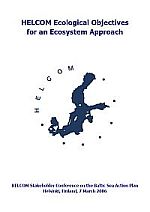The process of defining a Healthy Sea
What do we want the future Baltic Sea ecosystem to look like?
How can science and management support our common vision?
From plans to actions
In order to bridge the gaps between general public, science and management HELCOM works towards an improved assessment system for the Baltic Sea environment. These developments are part of the HELCOM work towards implementing Ecosystem Approach to Management, requiring unambiguous ecological information and objectives to guide management decisions aiming at a diverse and healthy Baltic Sea.
Ecological Objectives for the Baltic Sea has been part of the ecosystem assessment concept developed by the HELCOM EcoQO Project (Development of Ecological Quality Objectives for the Baltic Sea) which ended in 2005 with a final report. Presently the developed objectives form the core of the HELCOM Baltic Sea Action Plan and will be defined and developed further as parts of the Action Plan activity.
Stepwise approach
In order to complete the task of defining “good environmental status“ for the Baltic Sea in quantifiable terms HELCOM has selected a stepwise approach.
The first step is the joint setting of general targets, embodied as Strategic Goals and Ecological Objectives. These “headlines” can then be used to communicate with a wider stakeholder community ranging from scientists and politicians to ordinary citizens. The aim is to use the Ecological Objectives as a tool to link environmental monitoring, assessments, research and management.
Figure 1. The proposed system of Ecological Objectives. Each Objective will be exactly defined by target levels of specific indicators. Some possible Objectives for maritime activities are included in this table (lighter colour) but they should be considered less developed.
The HELCOM EcoQO Project has also sown the seeds for the next step in the process by drafting sets of measurable indicators for each ecological objective, thus also contributing to the ongoing revision of the HELCOM monitoring programs. Using a common system of indicators will enable the monitoring results obtained by individual countries, agencies and scientists to be compared more easily, greatly facilitating the evaluation of the present state of the Baltic marine environment. Existing indicators available from this website are part of this process.
The final and most crucial step in finalising the descibed system, defining exact target levels for the indicators, is a complex issue requiring intensive research and modelling work. At present date there are various ongoing activities defining target levels for environmental parameters in the HELCOM contracting parties. For the HELCOM Contracting Parties being also the EC Member States these activities are responses to the requirements of EC Directives such as the Water Framework Directive.
For these reasons the exact definitions (e.g. in terms of target values) of the objectives have not been proposed by the project but will naturally be needed in the near future to make the assessment system operational.
Further activities under way
The work towards Baltic Sea target levels has already been initiated for eutrophication within the HELCOM EUTRO and HELCOM EUTRO-PRO projects, and will continue for other parameters over the coming years. A new HELCOM Project “Marine ecological quality in the conceptual framework for assessing eutrophication” will specifically address biodiversity assessment issues. The project will run with EU funding until 2007.
Background for the activity
In the 1992 Convention, the HELCOM Contracting Parties Denmark, Estonia, European Community, Finland, Germany, Latvia, Lithuania, Poland, Russia and Sweden commit themselves to promote the ecological restoration of the Baltic Sea Area and the preservation of its ecological balance. The aim to reach ecological balance echoes the consensus reached at the UNCED 1992 and was, in addition to HELCOM, simultaneously adopted by other regional Marine Conventions e.g. OSPAR for the north-eastern Atlantic. Even if the wording of ecological balance is presently a bit outdated, the vision of a Baltic Sea ecosystem undisturbed by human activities is still valid and work remains to reach that state.
The joint Bremen HELCOM/OSPAR Ministerial Declaration 2003 put the ecosystem approach at the centre of HELCOM work (§ 6-9), involving development of sets of coherent and integrated ecological quality objectives incorporating all topics of concern. The HELCOM Ministerial Declaration in Bremen 2003 further stated that HELCOM activities will be built on e.g. the future European Marine Strategy and that ecosystem approach including nature conservation and biodiversity will be among the priority issues for HELCOM in the near future. The Ministers invited HELCOM, with the view to facilitate the development and implementation of the most effective set of measures to combat eutrophication, to develop and apply Ecological Quality Objectives with appropriate indicators of the eutrophication status which express “good quality status” as stipulated in the European Community Water Framework Directive (2000/60/EC), but covering the whole Baltic Sea.
As a part of the post-Bremen HELCOM efforts towards an ecosystem approach for the Baltic Sea, a pilot project for Ecological Quality Objectives for the Baltic Sea was set up in 2003. This pilot was followed by further elaboration of the concept in 2004 with German funding. The Danish Environmental Protection Agency has financed a report on indicators for oil and hazardous substances in the Baltic Sea (COWI 2004) to support HELCOM indicator developments.
The European Commission funded the present HELCOM EcoQO Project as a part of the Baltic implementation of the European Marine Strategy –the draft European marine environmental protection framework.
For further information about the Ecological Objectives developed for the Baltic Sea Action Plan, click the coverpage below.
.



